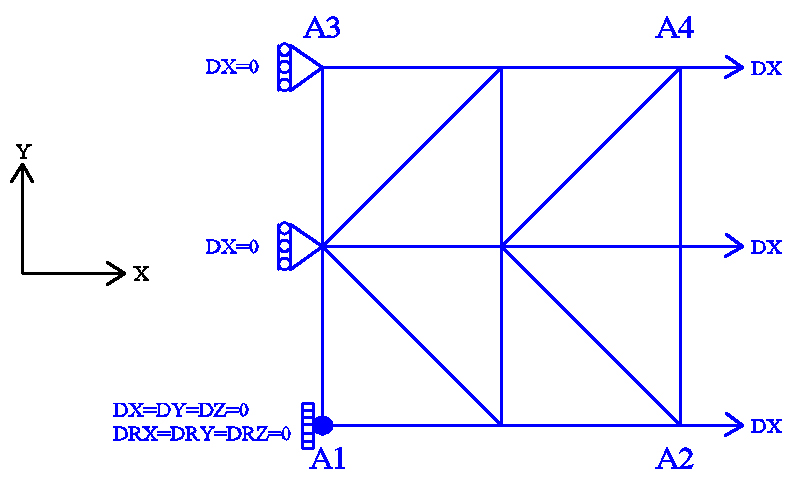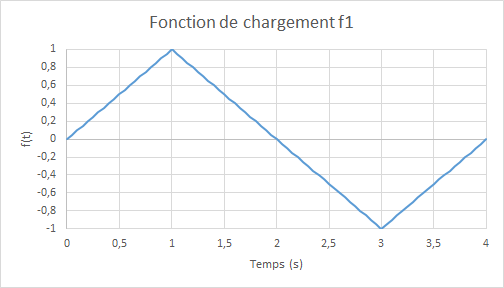3. Modeling A#
3.1. Characteristics of modeling#
The load is of the traction — compression — pure traction type.
\(\mathrm{A6}\)

Figure 3.1-a : mesh and boundary conditions.
Modeling: DKT
Boundary conditions:
Embedding in \({A}_{1}\);
\(\mathrm{DX}=0.0\) on the \({A}_{1}-{A}_{3}\) edge;
\(\mathrm{DX}={U}_{0}\times f(t)\) on the \({A}_{2}-{A}_{4}\) edge;
where \({U}_{0}=2.0\times {10}^{-4}m\) and \(f(t)\) represent the amplitude of cyclic loading as a function of the (pseudo-time) parameter \(t\). To properly verify the model, two loading functions are considered as follows:

|

|
Figure 3.1-b : f loading functions f1 (left) and f2 (right) .
Note: the extreme deformation is: \(2.0\times {10}^{\mathrm{-}4}\) , which is well below the transition to plasticity of steels. No integration time: \(0.05\) .
3.2. Characteristics of the mesh#
Number of knots: 9. Number of stitches: 8 TRIA3; 8 SEG2.
3.3. Tested quantities and results for the f1 loading function#
We compare the sum of the reaction forces along the axis \(\mathrm{Ox}\) in \(\mathit{A1}\mathrm{-}\mathit{A3}\) and the displacements along the axis \(\mathrm{Oy}\) in \(\mathit{A4}\) (Poisson effect) obtained by the multilayer modeling with the ENDO_ISOT_BETON law and by that based on the BETON_REGLE_PR law, in terms of relative differences, in terms of relative differences; the tolerance is taken as an absolute value on these relative differences:
Identification |
Reference type |
Reference value |
Tolerance |
|
TRAC. - PHASE CHAR. ELAS . \(t=\mathrm{0,25}\) |
||||
Relative difference in efforts \({N}_{\mathrm{xx}}\) |
|
0 |
1 10-2 |
|
Relative difference in displacement \(\mathrm{DY}\) |
|
1 10-6 |
||
TRAC. - PHASE CHAR. ENDO . \(t=\mathrm{1,0}\) |
||||
Relative difference in efforts \({N}_{\mathrm{xx}}\) |
|
0 |
1 10-2 |
|
TRAC. - PHASE DECHAR. ELAS . \(t=\mathrm{1,5}\) |
||||
Relative difference in efforts \({N}_{\mathrm{xx}}\) |
|
0 |
1.1 |
|
COMPR. - PHASE CHAR. ELAS . \(t=\mathrm{3,0}\) |
||||
Relative difference in efforts \({N}_{\mathrm{xx}}\) |
|
0 |
1 10-2 |
|
COMPR. - PHASE DECHAR. ELAS \(t=\mathrm{3,5}\) |
||||
Relative difference in efforts \({N}_{\mathrm{xx}}\) |
|
0 |
3 10-2 |
Comparative graphs efforts \({N}_{\mathrm{xx}}\) — displacement \(\mathrm{DX}\) in traction/compression for load \(\mathrm{f1}\) :: **

Comparative graphs displacement \(\mathrm{DY}\) (due to the Poisson effect) as a function of time:

3.4. Tested quantities and results for the f2 loading function#
We compare the reaction forces along the \(\mathrm{Ox}\) axis and the displacements along the \(\mathrm{Oy}\) axis in \(\mathit{A4}\) obtained by the multilayer modeling with the ENDO_ISOT_BETON law and by the one based on the BETON_REGLE_PR law, in terms of relative differences; the tolerance is taken in absolute value on these relative differences:
Identification |
Reference Type |
Reference Value |
Tolerance |
|
COMPR. - PHASE CHAR. ELAS . \(t=\mathrm{0,25}\) |
||||
Relative difference in efforts \({N}_{\mathit{xx}}\) |
|
0 |
3 10-2 |
|
COMPR. - PHASE CHAR. ENDO . \(t=\mathrm{1,0}\) |
||||
Relative difference in efforts \({N}_{\mathrm{xx}}\) |
|
0 |
5 10-2 |
|
COMPR. - PHASE DECHAR. ELAS . \(t=\mathrm{1,5}\) |
||||
Relative difference in efforts \({N}_{\mathit{xx}}\) |
|
0 |
3 10-2 |
|
COMPR . - PHASE DECHAR. ELAS . \(t=\mathrm{2,25}\) |
||||
Relative difference in efforts \({N}_{\mathrm{xx}}\) |
|
0 |
1 10-2 |
|
TRAC. - PHASE CHAR. ELAS . \(t=\mathrm{3,0}\) |
||||
Relative difference in efforts \({N}_{\mathrm{xx}}\) |
|
0 |
1 10-1 |
|
TRAC. - PHASE DECHAR. ELAS . \(t=\mathrm{3,5}\) |
||||
Relative difference in efforts \({N}_{\mathrm{xx}}\) |
|
0 |
1.1 |
Comparative graphs \({N}_{\mathrm{xx}}\) — displacement \(\mathrm{DX}\) in traction/compression for load \(\mathrm{f2}\) :: **

3.5. notes#
According to the previous curves, it can be seen that the multilayer model with law BETON_REGLE_PR represents the overall behavior of reinforced concrete under tension — pure compression in a satisfactory manner under load. However, in discharge, law BETON_REGLE_PR follows the same curve as the charge, unlike law ENDO_ISOT_BETON.
The Poisson effect is not modelled by law BETON_REGLE_PR, so we obtain a zero displacement in the transverse direction DY.
A symmetry of the response is observed depending on the chosen direction of compression-traction load or inverse, depending on the load \(\mathit{f1}\) or \(\mathit{f2}\) for law BETON_REGLE_PR.